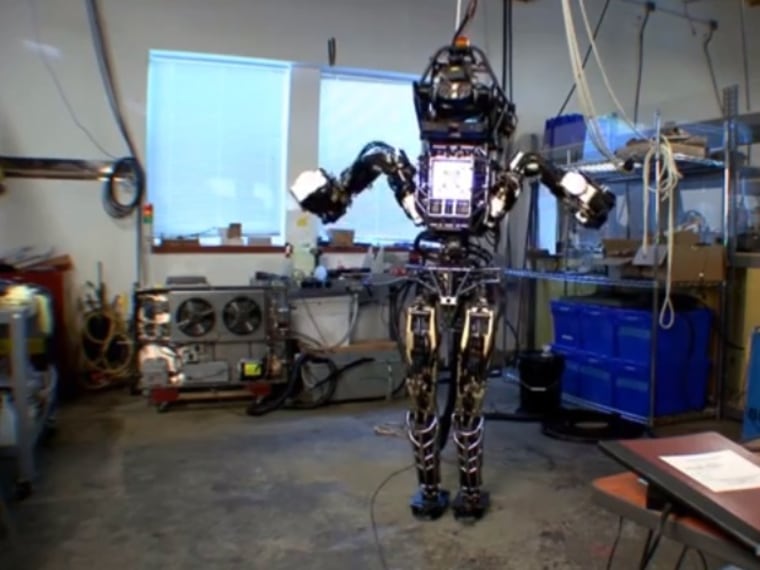Atlas can't compete with anything out of "Pacific Rim," that summer science fiction blockbuster in which gigantic human-controlled "mecha" robots rise up and defend humans against an attacking monster race.
But the latest and largest version of the hunky humanoid (built by Boston Dynamics and funded by DARPA) does sort of look the part, glowing chest plate and all.
"It looked like what a science fiction robot should look like," confirms Stephen Cass, a senior editor at IEEE Spectrum who saw the robot at this week's reveal and wrote about it. "This is a very big, very impressive structure, bigger than a person," Cass told NBC News.
Six-foot-two and 330 lbs, Atlas might look like it could crush any human in a cage-match. But for the next few months, copies of the Boston Dynamics robot will be trained to rush to humanity's aid — not to fend of an invading race of monsters from a different dimension perhaps — but as future helpers in dangerous disaster scenarios like the one at the Fukushima nuclear plant in 2011.
"During the first 24 hours, if it would've been possible to vent the reactors (using robots), the explosions would not have occurred and the disaster would have been much less severe," Gill Pratt, program manager for the DARPA Robotics Challenge, explained in a telephone briefing with reporters a few weeks ago.
Seven teams of robotics researchers across the country have been assigned one Atlas each. They'll customize and program their version of Atlas to perform a laundry-list of mock-disaster-response tasks, preparing for the next round of the DARPA Robotic Challenge trials slated for December this year.
The teams were picked in June as finalists in the Virtual Robotics stage of DARPA's lengthy contest, which hopes to jump start innovation in rescue robotics. The teams now have a chance to apply their simulations to a bot in the real world.
As DARPA explains in a blog post, Atlas is merely "a physical shell for the software brains and nerves that the teams will continue to develop and refine." Cass points out that the next few months will give Atlas' human teammates a chance to get used to working alongside the powerful machine, with its "big body that can move quickly."
On top of directing movements for the robot, teams have the option to switch out arm parts with those made by a few companies, to customize their robot to tackle the gauntlet laid out by DARPA.
On its "head," Atlas has stereo cameras and a laser rangefinder. "The eyes of the sensor head were slightly higher than my own eyes," Cass said. He reasons that this positioning would help engineers operating the robot in uneven or dangerous terrain if they had a familiar point of view. "You want to give them a view which is similar to what they can see," he said.
For now, the new Atlas hasn't been seen doing much more than walking or moving its arms. But from what we can tell, this kid has potential.
DARPA released a new video of Atlas yesterday, which also features other versions of the robot. Watch one bot steps over a wide mock canyon, using its arms as supports. Then, when a battering ram crashes into another Atlas lookalike, note how the robot keeps its balance while standing on not two, but just one leg.
For more images of Atlas, visit Stephen Cass's post at IEEE Spectrum.
Nidhi Subbaraman writes about technology, science and robots, robots, robots. Follow her on Facebook, Twitter and Google+.
